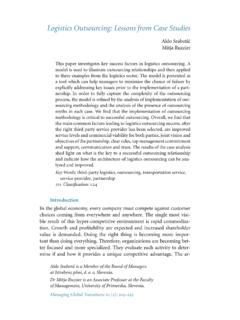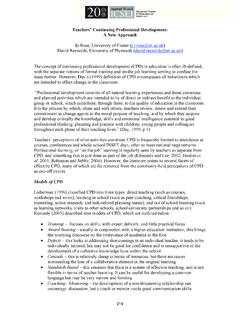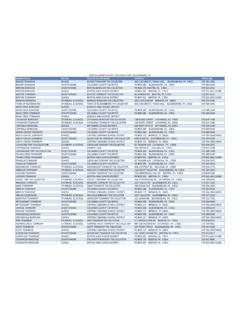Transcription of How Internal and External Sources of Knowledge Contribute ...
1 How Internal and External Sources of Knowledge Contribute to Firms' innovation performance Anja Coti c Svetina Igor Prodan This paper investigates the extent to which di erent Knowledge Sources Contribute to firms' innovation performance . The empirical analysis estimates the relationships in the structural model of the influence of Knowledge Sources on innovative performance using data collected through personal interviews at 303 firms. The results reveal that Internal Sources have the most important influence on firms' innovative per- formance and confirm that, in their innovation process, firms mostly rely on Knowledge developed through in-house r&d e orts, continu- ous improvement, and Internal education and training programs.
2 The data show that in-house learning is not su cient for generating in- novation and that firms need to supplement Internal Knowledge with Knowledge acquired outside the firm . They mainly need to secure links with firms and institutions in the global environment if they want to secure the inflow of new ideas and approaches that will eventually lead to innovations. Key Words: Knowledge , innovation , structural equation modeling jel Classification: o30, o31. Introduction An interactive view of innovation has been developed within the frame- work of a learning economy, in which innovation is seen as a techni- cal and social process based on the complex interaction between firms and their environment (Asheim and Isaksen 1997).
3 Most authors agree that the use of Internal and External Knowledge Sources contributes pos- itively to firms' innovation performance , but the relationship has been empirically tested only to a limited extent (Capello 1999; Caloghirou, Kastelli, and Tsakanikas 2004; Capello and Faggian 2005). This paper in- vestigates the extent to which various Knowledge Sources Contribute to firms' innovation performance . More specifically, it identifies on the one Dr Anja Coti c Svetina is an Assistant at the Faculty of Economics, University of Ljubljana, Slovenia. Dr Igor Prodan is an Assistant Professor at the Faculty of Economics, University of Ljubljana, Slovenia. Managing Global Transitions 6 (3): 277 299.
4 278 Anja Coti c Svetina and Igor Prodan hand the level of importance of Internal Knowledge Sources embodied mainly in in-house r&d e orts. On the other hand, it looks at exter- nal Sources of Knowledge and identifies how the use of local, national, and international Knowledge Sources determines firms' innovation per- formance. This paper extends the work of other scholars as to what are the Sources of innovation , by considering how Knowledge Sources at dif- ferent spatial levels influence the innovation performance of firms. While most authors analyzed the role of External Knowledge Sources in general (Caloghirou, Kastelli, and Tsakanikas 2004; Willoughby and Galvin 2005.)
5 Tsai and Wang 2007; Love and Mansury 2007), we divide them according to the geographical proximity to the observed firm . As such, this is one of the few empirical papers that assesses simultaneously to what extent Internal , local, national and international Knowledge Sources Contribute to firms' innovation . The empirical analysis is based on a survey that was carried out in seven European countries: the Czech Republic, Germany, Italy, Poland, Romania, Slovenia, and the United Kingdom. The relationships in the structural model of the influence of Sources of Knowledge on innovation performance are estimated using data collected through personal inter- views at 303 firms.
6 The results reveal that Internal Sources have the most important influence on firms' innovative performance and confirm that, in their innovation process, firms mostly rely on Knowledge developed through in-house r&d e orts, continuous improvements and Internal education, and training programs. The data show that in-house learn- ing alone is not su cient for generating innovation and the firms need to supplement Internal Knowledge with Knowledge acquired outside the firm . They mainly need to secure links with firms and institutions in the extra-local environment in order to secure the inflow of new ideas and approaches that will eventually lead to innovations. The paper is structured in five sections.
7 The next section presents the theoretical framework on which the empirical analysis is based. The main focus is on the literature describing the importance of Internal and External Knowledge Sources and how they Contribute to firms' innova- tive performance . Then four hypotheses are developed, which are later empirically tested. The third section describes the methodology used, in- cluding the sampling and data collection process, data analysis, and op- erationalization and measure validation. The fourth section is dedicated to presenting the empirical findings together with a graphic presenta- tion of the structural model. The results are summarized and the main findings discussed in the last section.
8 Managing Global Transitions Internal and External Sources of Knowledge 279. Acquiring Knowledge for innovation : Theory and Hypotheses Development Until the 1980s, understanding of the innovation process was strongly influenced by the linear model of innovation , which suggested that de- velopment of innovations follows a straight research-to-market trajec- tory. In this model a central role was given to r&d activity, and firms'. innovative performance was mainly seen as a consequence of r&d in- vestment. This research-based and technocratic view of the innovation process could not explain the success of several sme firms that had lim- ited resources for in-house r&d but were able to base their competitive- ness on constant innovation .
9 This phenomenon of innovative smes has become especially apparent in several sme clusters that have emerged all over Europe and the rest of the world. Since then, several scholars and practitioners have tried to reveal the dynamics behind small and medium-sized firms' innovativeness. More than a decade ago it became obvious that innovations rarely occur as creative acts of individual ge- niuses, but more often as a result of interactive processes. Individuals can not learn new things in a cognitive vacuum and learning always takes place in relation to some kind of social context (Johnson 1992; Lundvall 1992). From the perspective of innovation , new Knowledge is not only developed in r&d departments but also in connection with ordinary production activities of firms and other actors through the interactive learning process (Eriksson 2005).
10 Firms cooperate with their suppliers, customers, Knowledge institutions (universities, laboratories, etc.), and even with their competitors when developing new products and services or improving production processes. The interactive model of innovation explains the process of innovation as a network of Knowledge -flows both within the organization, and in the relationship between the organiza- tion and the environment (Santos 2000). Internal and External Sources of Knowledge This section aims to show how complex the process of Knowledge acqui- sition is, and to present the idea that firms need to acquire new knowl- edge from numerous Internal and External Sources in order to constantly generate innovations and maintain their competitive edge.















